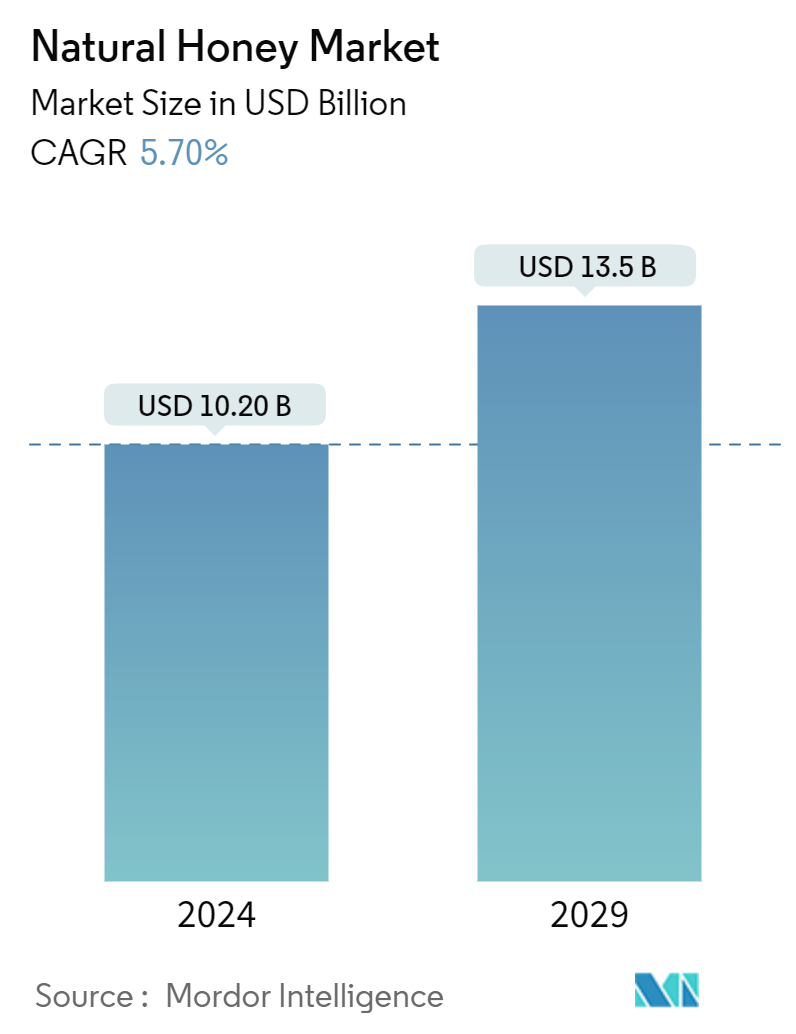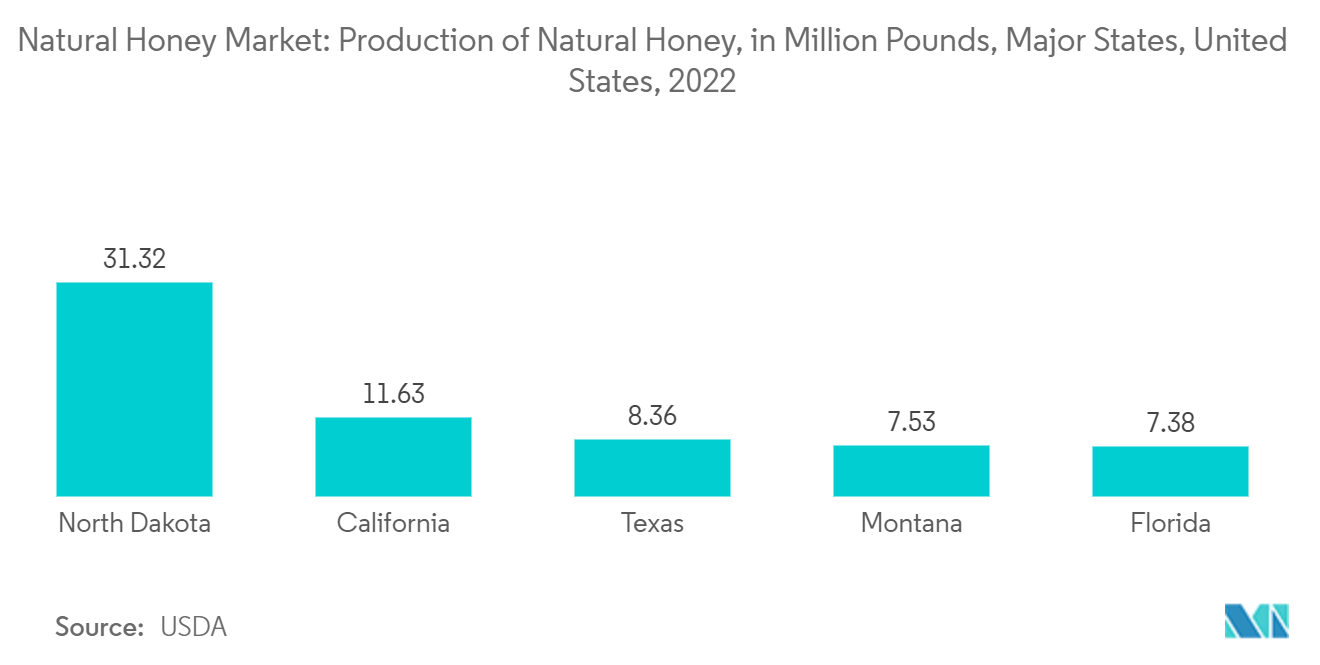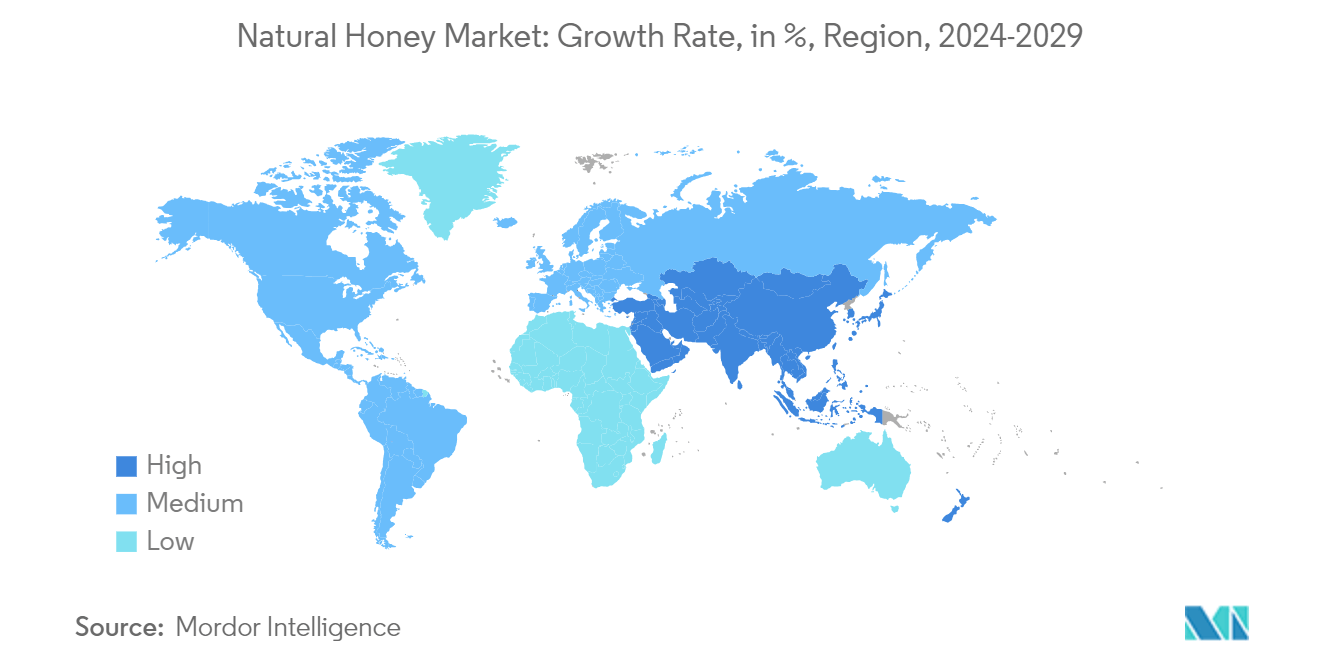Natural Honey Market Size

| Study Period | 2019 - 2029 |
| Market Size (2024) | USD 10.20 Billion |
| Market Size (2029) | USD 13.5 Billion |
| CAGR (2024 - 2029) | 5.70 % |
| Fastest Growing Market | North America |
| Largest Market | Asia-Pacific |
Major Players*Disclaimer: Major Players sorted in no particular order |
Natural Honey Market Analysis
The Natural Honey Market size is estimated at USD 10.20 billion in 2024, and is expected to reach USD 13.5 billion by 2029, growing at a CAGR of 5.70% during the forecast period (2024-2029).
Natural honey is a sweet-flavored liquid food produced by various pieces of wild bees. It differs from regular honey as it does not undergo commercial processes such as filtration or pasteurization but collects and packs directly from the beehives. It is largely used as a natural sweetener and the best alternative to white sugar for health-conscious people. It can be used in beverages, processed foods, jams, and jellies and is increasingly used as an ingredient in health and beauty products. Honey has been linked to various health benefits. Studies have found that it may help reduce risk factors for heart diseases like blood pressure and cholesterol and improve wound healing and throat infections. It contains various nutrients, including vitamins, minerals, calcium, and antioxidants. With increasing consumer demand and high health benefits, the market is expected to grow over the forecast period and have a long-term impact.
Along with this, the potential of honey to impart a pleasant flavor to food and beverage products, together with their easy accessibility and longer shelf life of the product is boosting market demand. Moreover, Beeswax is a byproduct of honey production. It is a wonderful ingredient in aromatherapy, cosmetics, skincare products, wood finishes, waxes, waterproofing products, and dental molds. The increased usage will help to increase the natural honey.
According to the CBI Ministry of Foreign Affairs, Europe is the world's second-largest honey producer after China. In 2021, Europe accounted for over 13% of global production, totaling 1,772 thousand metric tons. In 2022, Europe had more than 20.2 million hives dedicated to the beekeeping industry. The number of hives has grown steadily over the last 5 years, at an average annual rate of 4.0%. European honey production has fluctuated considerably in recent years. Overall, honey production showed 228,300 metric tons in 2021, between 2021 and 2022 significant growth was recorded, reaching 285,700 metric tons. This performance corresponds to an average growth of 1.0% per year for 2019-2022. The European demand for honey is strong and growing. Importers are increasingly looking for new suppliers. The German, British, French, and Belgian markets account for more than 50% of total European honey imports.
Natural Honey Market Trends
Increasing Demand for Natural Sweeteners with Health Benefits of Natural Honey
The rising consumer preferences for healthy and natural alternatives over artificial sweeteners and increasing awareness about the benefits of honey are majorly driving the growth of the natural honey market. Artificial sweeteners lead to obesity, elevated cholesterol, mineral depletion, tooth decay, hypertension, and cardiovascular diseases. They are also responsible for causing Type 2 diabetes, metabolic syndrome, and different types of cancers and tumors. On the other hand, natural honey has a lower glycemic index (GI), which means that it does not raise blood sugar levels quickly, and it is also filled with antioxidants that offer substantial benefits to the human body. They have many health benefits and can be used in functional foods, skincare products, etc. Natural honey is a pure, unfiltered, and unpasteurized sweetener made by bees from the nectar of flowers and is known for its incredible nutritional value and health powers. It is progressively advocated as a substitute for sugar due to its health benefits. There is enough research that proves that replacing sugar with honey can help prevent gaining weight and also lower blood sugar levels. A daily dose of raw honey raises levels of good antioxidants in the body that help boost the immune system.
Furthermore, governments and international organizations have been promoting natural honey as an important food ingredient and a beneficial mediational ingredient. For instance, according to the USDA Sugars and Sweeteners Outlook Report 2022, the United States is the second-largest honey consumer behind China, with consumption reaching 618 million pounds in 2021, an 8% increase versus 2020, translating about 1.9 pounds per capita in 2021. Additionally, the World Health Organization (WHO) has recommended it as an effective natural remedy for cough in small children, as well as for chronic cough in adults. The honey-based spread is a growing market in North America and Europe in terms of clean labeling. About 50% of the American population consumes honey. The purity and naturalness of honey are the crucial criteria consumers consider while purchasing the product. Thus, the popularization and demand for natural sweeteners is projected to drive the market during the forecast period.

Asia-Pacific Dominates the Market
Asia-Pacific registers as the dominant market for natural honey across the world. China holds the largest share of honey production and consumption in Asia-Pacific, followed by India. China's vast territory, rich nectar source, large population, and improvement in people's living standards are the reasons for the rise in domestic natural honey production. Honey, in China, is a staple food available more easily than sugar in a supermarket. In 2020, with a population of more than 1.4 billion inhabitants, honey consumption exceeded 300,000 metric tons per year in China. In 2021, China produced almost 500,000 metric tons of natural honey, according to the United Nations Food and Agriculture Organization (FAO). Even though its natural properties are being contested by several national and intranational watchdogs scanning for syrup additives to the People's Republic's bee-based commodity, the amount of honey produced still easily outranks every other country.
Along with this, the import volume increased in China from 4,222 metric tons in 2020 to 4,765 metric tons in 2021. China is the official European supplier to importing countries like Spain, Germany, and the United Kingdom. As the natural honey demand is increasing in this region, companies have started introducing new varieties to the Asian-Pacific region. For instance, DELTA Commerce offers organic honey in varieties like thyme, lavender, rosemary, eucalyptus, etc. Kato Brothers Honey Co. Ltd introduced Sakura honey as its specialty in the Japanese market.
Moreover, India is among the top and leading producers of honey in this region, next to China. Additionally, it also exports natural honey to a number of countries globally, like the United States, Canada, and Qatar, among others. The country also offers several different exotic varieties of wild honey like the Multi-flora Himalayan honey, eucalyptus honey, lychee honey, and many others. As per the Agricultural and Processed Food Products Export Development Authority (APEDA), the country has exported 79,929.17 metric tons of Natural Honey to the world for the worth of INR 1,622.77 Crore/ 203.07 USD Million during the year 2022-23, with the major export destinations are the United States, United Arab Emirates, Saudi Arabia, Libya, and Canada.

Natural Honey Market News
- May 2024: The government of Canada is increasing funding to the Honey Bee Health Initiative by up to USD 1 million to help improve the resiliency and competitiveness of beekeeper operations in Ontario. The additional funding will help more Ontario beekeepers better protect their colonies over the winter and protect against invasive pests such as varroa mites which pose a serious threat to honeybee health.
- August 2022: The Agricultural and Processed Food Products Export Development Authority (APEDA), Ministry of Commerce and Industry, for export promotion of honey involving exporters, stakeholders, and government officials in Chandigarh, Punjab launched a project under the part of the government’s AtmaNirbhar Bharat initiative to boost honey production, the government has approved an allocation of INR 500 crore (USD 60.5 million) for the National Beekeeping and Honey Mission (NBHM) for three years (2020-21 to 2022-23) to encourage farmers towards honey farming by ensuring quality production.
Natural Honey Market Report - Table of Contents
1. INTRODUCTION
- 1.1 Study Assumptions and Market Definition
- 1.2 Scope of the Study
2. RESEARCH METHODOLOGY
3. EXECUTIVE SUMMARY
4. MARKET DYNAMICS
- 4.1 Market Overview
- 4.2 Market Drivers
- 4.3 Market Restraints
- 4.4 Value Chain Analysis
5. MARKET SEGMENTATION
-
5.1 Geography (Production Analysis, Consumption Analysis by Value and Volume, Import Analysis by Value and Volume, Export Analysis by Value and Volume, and Price Trend Analysis)
- 5.1.1 North America
- 5.1.1.1 United States
- 5.1.1.2 Canada
- 5.1.1.3 Mexico
- 5.1.2 Europe
- 5.1.2.1 Spain
- 5.1.2.2 Ukraine
- 5.1.2.3 Poland
- 5.1.2.4 Germany
- 5.1.3 Asia-Pacific
- 5.1.3.1 China
- 5.1.3.2 India
- 5.1.3.3 Japan
- 5.1.3.4 New Zealand
- 5.1.4 South America
- 5.1.4.1 Argentina
- 5.1.4.2 Brazil
- 5.1.5 Middle East and Africa
- 5.1.5.1 Turkey
- 5.1.5.2 Iran
6. MARKET OPPORTUNITIES AND FUTURE TRENDS
** Subject To AvailablityNatural Honey Industry Segmentation
Honey, a sweet and viscous liquid, boasts a dark golden hue. It's crafted in the honey sacs of diverse bees, sourced from flower nectar. Geography segments the Honey Market into North America, Europe, South America, Asia-Pacific, Middle-East, and Africa. The report includes the Production Analysis (Volume), Consumption Analysis (Value and Volume), Export Analysis (Value and Volume), Import Analysis (Value and Volume), and Price Trend Analysis. The report offers market estimation and forecasts in value(USD) and volume(metric tons) for all the above segments.
| Geography (Production Analysis, Consumption Analysis by Value and Volume, Import Analysis by Value and Volume, Export Analysis by Value and Volume, and Price Trend Analysis) | North America | United States |
| Canada | ||
| Mexico | ||
| Geography (Production Analysis, Consumption Analysis by Value and Volume, Import Analysis by Value and Volume, Export Analysis by Value and Volume, and Price Trend Analysis) | Europe | Spain |
| Ukraine | ||
| Poland | ||
| Germany | ||
| Geography (Production Analysis, Consumption Analysis by Value and Volume, Import Analysis by Value and Volume, Export Analysis by Value and Volume, and Price Trend Analysis) | Asia-Pacific | China |
| India | ||
| Japan | ||
| New Zealand | ||
| Geography (Production Analysis, Consumption Analysis by Value and Volume, Import Analysis by Value and Volume, Export Analysis by Value and Volume, and Price Trend Analysis) | South America | Argentina |
| Brazil | ||
| Geography (Production Analysis, Consumption Analysis by Value and Volume, Import Analysis by Value and Volume, Export Analysis by Value and Volume, and Price Trend Analysis) | Middle East and Africa | Turkey |
| Iran |
Natural Honey Market Research FAQs
How big is the Natural Honey Market?
The Natural Honey Market size is expected to reach USD 10.20 billion in 2024 and grow at a CAGR of 5.70% to reach USD 13.5 billion by 2029.
What is the current Natural Honey Market size?
In 2024, the Natural Honey Market size is expected to reach USD 10.20 billion.
Which is the fastest growing region in Natural Honey Market?
North America is estimated to grow at the highest CAGR over the forecast period (2024-2029).
Which region has the biggest share in Natural Honey Market?
In 2024, the Asia-Pacific accounts for the largest market share in Natural Honey Market.
What years does this Natural Honey Market cover, and what was the market size in 2023?
In 2023, the Natural Honey Market size was estimated at USD 9.62 billion. The report covers the Natural Honey Market historical market size for years: 2019, 2020, 2021, 2022 and 2023. The report also forecasts the Natural Honey Market size for years: 2024, 2025, 2026, 2027, 2028 and 2029.
What are the key regulatory challenges in the Natural Honey Market?
The key regulatory challenges in the Natural Honey Market are a) Balancing consumer demand for affordable honey with sustainable beekeeping practices b) Balancing the need for informative labels with preventing misleading claims and ensuring consumer protection
What are the key regulatory challenges in the Natural Honey Market?
The key regulatory challenges in the Natural Honey Market are a) Balancing consumer demand for affordable honey with sustainable beekeeping practices b) Balancing the need for informative labels with preventing misleading claims and ensuring consumer protection
What are the key regulatory challenges in the Natural Honey Market?
The key regulatory challenges in the Natural Honey Market are a) Balancing consumer demand for affordable honey with sustainable beekeeping practices b) Balancing the need for informative labels with preventing misleading claims and ensuring consumer protection
Organic Honey Industry Report
The organic and natural honey markets are witnessing significant growth, driven by consumer demand for natural, chemical-free products and a surge in health and sustainability awareness. This growth is supported by organic beekeeping practices and a shift towards healthier lifestyles, emphasizing organic honey's medicinal properties like antioxidants and antibacterial benefits. The rise of e-commerce has made organic honey more accessible globally, with consumers willing to pay a premium for high-quality, certified products.
The trend towards health and environmental sustainability is also evident in the global natural honey sector, with innovations and a variety of flavors driving consumer interest. Both organic and conventional processing segments are expanding, reflecting a broader movement towards natural sweeteners and healthier food choices. This dynamic market landscape, characterized by increasing honey revenue and evolving honey trends, is detailed in Mordor Intelligence™ Industry Reports, highlighting the market's promising outlook.
Industry reports provide a comprehensive industry analysis, offering insights into the market size, market share, and market growth. The industry outlook is positive, with industry statistics showing a steady increase in market value. Industry research indicates that market leaders are capitalizing on the growing demand for organic products. Market segmentation reveals diverse consumer preferences, while market data and market forecast suggest continued expansion.
Industry trends demonstrate a shift towards sustainability and health consciousness, with market predictions supporting this trajectory. The market overview and market review highlight the importance of organic certification and quality assurance. Industry information and industry sales data underscore the significance of e-commerce in making organic honey more accessible. The report example and report pdf provide detailed insights into market dynamics, making it a valuable resource for research companies and stakeholders.



